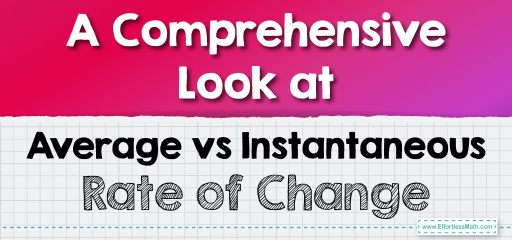A Comprehensive Look at Average vs Instantaneous Rate of Change
Understanding the concepts of average and instantaneous rates of change is crucial in calculus and real-world applications. These concepts are foundational in understanding the behavior of functions and their graphs.

The concepts of average and instantaneous rates of change are pivotal in the study of calculus and have extensive applications across various scientific and economic fields. These rates help in understanding how a quantity changes over time or in response to changes in other variables. The average rate of change offers a broad, overall view of the change across an interval, akin to observing the average speed of a vehicle over a specific journey. On the other hand, the instantaneous rate of change zooms in to examine the behavior at a specific point, much like checking the speedometer of a car at a precise moment. Together, these concepts provide a comprehensive understanding of the dynamics of change, whether in a physical system, an economic model, or any scenario where change is a factor.
Average Rate of Change
- Definition:
The average rate of change of a function over a specified interval gives an overall idea of the function’s behavior between two points. It’s like looking at the average speed of a car over a road trip.
- Mathematical Expression:
For a function \( f(x) \), the average rate of change between two points \( x = a \) and \( x = b \) is calculated as:
\( \frac{f(b) – f(a)}{b – a} \)
This formula represents the slope of the secant line passing through points \( (a, f(a)) \) and \( (b, f(b)) \) on the graph of \( f(x) \).
- Interpretation:
The average rate of change tells us how much the function’s value changes on average for each unit increase in \( x \) over the interval \([a, b]\).
Instantaneous Rate of Change
- Definition:
The instantaneous rate of change is the rate at which a function changes at a specific point. It’s akin to checking the speedometer of a car at a precise moment.
- Relation to Derivatives:
The instantaneous rate of change of \( f(x) \) at \( x = a \) is the derivative of \( f(x) \) at that point, denoted as \( f'(a) \).
- Mathematical Expression:
It is defined as the limit of the average rate of change as \( b \) approaches \( a \):
\( f'(a) = \lim_{b \to a} \frac{f(b) – f(a)}{b – a} \)
This limit, if it exists, is the slope of the tangent line to the curve \( f(x) \) at the point \( (a, f(a)) \).
- Interpretation:
The instantaneous rate of change gives a precise value of how fast the function is changing at exactly point \( a \).
Comparison and Real-World Applications
- Average vs Instantaneous:
- The average rate provides a broader view over an interval, whereas the instantaneous rate is specific to a single point.
- For example, the average rate can be like calculating the average speed of a trip, while the instantaneous rate is like checking the current speed at a particular moment.
- Applications:
- In physics, these concepts are crucial for understanding motion—average velocity vs instant velocity.
- In economics, they help in analyzing the overall growth of a company over a year (average) versus its growth rate in a specific quarter (instantaneous).
Related to This Article
More math articles
- How to Solve Word Problems Involving the One-Step Equation
- How to Add Polynomials to Find Perimeter
- 3rd Grade SOL Math Worksheets: FREE & Printable
- The Ultimate 6th Grade RISE Math Course (+FREE Worksheets)
- FTCE General Knowledge Math- Test Day Tips
- 8th Grade DCAS Math Worksheets: FREE & Printable
- Top 10 5th Grade PSSA Math Practice Questions
- Embarking on an Adventure: How to Solve Word Problems Involving Percents of Numbers and Percent Equations
- How to Multiply and Divide Rational Numbers
- How to Solve Coterminal Angles and Reference Angles? (+FREE Worksheet!)


























What people say about "A Comprehensive Look at Average vs Instantaneous Rate of Change - Effortless Math: We Help Students Learn to LOVE Mathematics"?
No one replied yet.